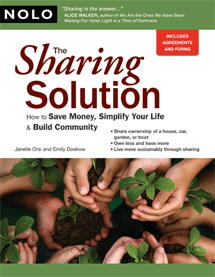An NBC News “Making a Difference” segment caught my attention: a clothing swap being organized in my home state of Michigan. Whenever the car industry tanks, it takes the whole Michigan economy down with it. What struck me about the clothing swap story was how the idea was spreading–more and more women were choosing to organize their own swaps. I think it’s the upside of a down economy. I don’t wish unemployment on anyone, but watching people come together to share resources in creative ways can only be good for community and the planet.
The news segment left me wondering what the organizing meetings looked like. I have been working and living collaboratively in a variety of ways since I was 19 years old (see About Me on this blog site). If you’ve ever been in a community group or been part of a team at work, you already know that making decisions with other people is not always the easiest thing. In particular, consensus decision making can be the most time-consuming and painful–though the benefit of having a really well thought out decision that everyone buys into is often worth the effort.
Nolo Press, dedicated to making US law accessible to everyone, just published a fabulous new book The Sharing Solution: How to Save Money, Simplify Your Life & Build Community that
covers how to share everything from clothing to child care to housing. (I was honored to be interviewed and have the story of my own co-housing arrangement and philosophies included in the book.) The Sharing Solution includes all kinds of helpful questions, considerations, checklists and processes for making agreements together. I have been a professional meeting facilitator for over 20 years now, so I read the chapter on “Making Decisions as a Group” with great curiosity. The chapter contains a good overview of the consensus process–what it is, how it works, why to use it–and includes a clear succinct flowchart created by Seeds for Change.
I was immediately struck by what it was missing: the number one tool in my experience for reaching consensus quickly and efficiently, which Interaction Associates (IA) coined Build Up/Eliminate. In essence, what could we add to the proposal (build up) or modify (eliminate) to make it work for everyone?
I’ve learned from and worked with Interaction Associates since the mid-90’s. The founders of IA created the very first meeting process that went beyond Robert’s Rules of Order–truly a gift to the planet, in my opinion, having suffered through many a long meeting “managed” by Robert’s Rules. I like IA’s definition of consensus (see page 23 of their eBook Fully Engaged: Essential People Strategies for Tough Times), which includes two key elements:
- Everyone has had a chance “to give their opinion and to understand the implications for various options.”
- Everyone “is willing to support and help implement [the decision]”
So what do you do when everyone has weighed in and there are a few people that just can’t live with the decision? Strong-arm or guilt them into going along so they don’t hold up the group? Repeat your point of view over and over until you exhaust them? Yeah, you’ve probably lived through these “techniques” yourself. They don’t produce genuine buy-in. They are very likely to damage relationships in the long run.
Here is a faster, more genuine route to consensus, based on IA’s Build Up/Eliminate process. It helps the group slow down briefly to reach consensus much faster:
- Ask the few people who are not in full agreement with everyone else:
- What specifically concerns you or doesn’t work for you about this proposal?
- Listen with an open mind. Are they seeing something you’ve missed? How is their perspective different from yours?
- Listen for any differences or misunderstandings in how words or details of the proposal are being defined.
- Listen for their underlying interest. While specific positions might be hard to reconcile, sometimes everyone has the same common underlying interest. Agreements are easier to build from those common starting points.
- Is there anything about this proposal that we could modify that would get you on board?
- Sometimes this is as easy as adding in clarifying detail or modifying the wording of the proposal slightly. In the battle to make our point heard, we overlook these easy opportunities.
- If the people with concerns don’t have suggestions, open it up to the group.
- What specifically concerns you or doesn’t work for you about this proposal?
- Make sure that the suggested changes work for everyone.
A little extra time spent asking focused questions like these will net you stronger, more genuine consensus and a well-thought out decision everyone can walk out ready to support and help implement.



